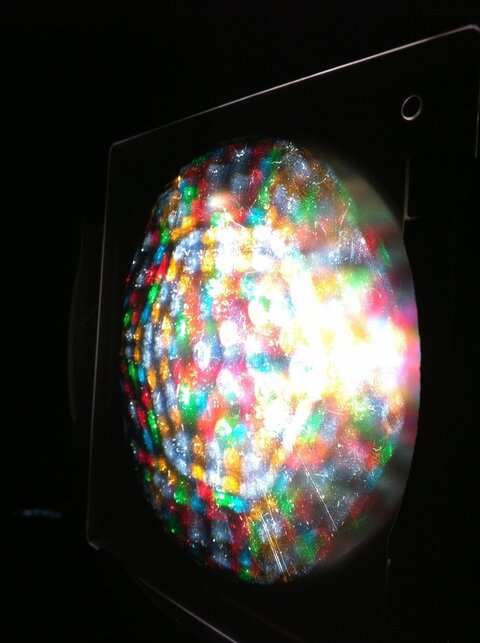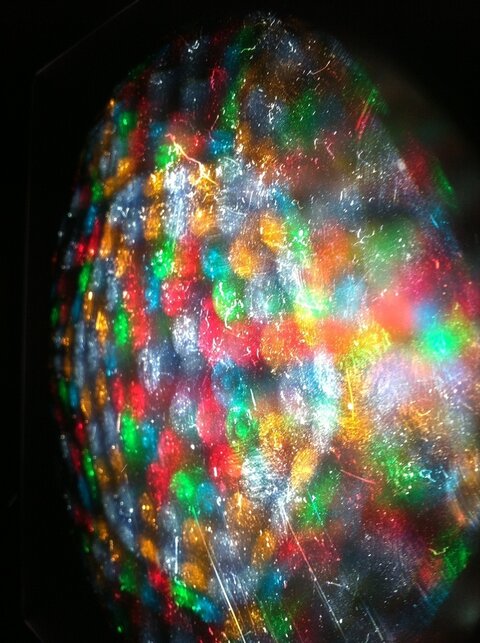JChenault
Well-Known Member
First look ETC Led S-4
I had the opportunity to take a look at the new ETC Source 4 LED Lustr. Thought it might be interesting to share.
At the Hemsley portfolio review, ETC brought in an LED unit, and an incandescent S-4. They compared them by focusing the units on a white wall about 35 to 40 feet from the fixture. Each unit had a 36 degree HiDef lens tube. The incandescent unit was lamped with a 575 watt Extended life ( IE dim) lamp. In brief - a very impressive fixture for a lot of applications. Here's what I saw and heard.
Brightness. First of all, the ETC party line seems to be that comparing to a 575 watt extended life lamp is a reasonable approach since the extended life lamp is the one most frequently used. Not sure where they got that data, but I feel a ControlBooth Poll coming on.
With all LED's on ( which give a reasonable approximation of white light ) the LED unit is about half as bright as the ungelled incandescent fixture. With intense colors, it was substantially brighter. I did not have the chance to dial in pastel colors and compare to the same gel in the incandescent fixture. My gut feeling is that the crossover point for intensity would be any gel that transmits about 25%. I am sure this number varies with the hue of the color.
The dimming curve is wonderful. They use a single channel, but ( according to the rep) internally convert the 8 bit value from the console to a 14 bit internal value based on rate of change over four cycles. We did some 30 second fades and I did not see any stepiness in the curve at all.
The beam is very precise. It shutters quite sharply, and has no appreciable color fringing. Let me say that again as it is important. No appreciable color fringing on a shutter cut. We put in a gobo, and had some slight color fringing when the gobo as we played with the focus. They have a special frost to put in the gate with the gobo to reduce this. The frost helped a little, but there was still a touch. Let me be clear though, I had to look hard to see any color fringing. If you had not known it was a color LED unit and had been looking for it I don't think you would have seen anything. Using the 'All leds on' color, there was about as much color fringing as you would get with an incandescent unit as it moves out of focus.
Shadows cast by the beam are very natural. We compared by setting up the LED and incandescent unit side by side, projected them to the same circle on the wall, and shuttering so that the right side of the beam was incandescent only, and the left side was LED only. We stood in front of the beam with our hands out to see what kind of shadows we got. The sharpness of the shadow was a bit better with the LED unit than the incandescent unit. If you looked hard you might be able to see a tinge of color fringing - but again you would have to look very hard. This fringing was only apparent when we were close to the fixture. IE with a 35 foot throw, when we were within 15 feet of the fixture. I would say there is no appreciable color fringing with shadows.
The LED unit is not a completely even field. It is hotter in the center and drops off a bit to the edges. This is be design so you can blend adjacent units. There is no way, however, to adjust the field of the LED's. IE no knobs on the back to even or spot the field of light. It does what it does.
The unit does have a fan. I could tell by putting my ear to the back of the fixture and I could feel the air flow. I COULD HEAR NOTHING!! This is the first silent cooling fan I have ever experienced, and that amazed me.
If you get a chance to see the unit, remove the lens tube. You get a pattern of the LED emitters projected on the wall in sharp focus. Pretty cool.
The price that was mentioned was $2500.
My takeaway - very interesting unit. At this point I don't think that it is bright enough for general use, but it does make sense for many applications. I was impressed.
I had the opportunity to take a look at the new ETC Source 4 LED Lustr. Thought it might be interesting to share.
At the Hemsley portfolio review, ETC brought in an LED unit, and an incandescent S-4. They compared them by focusing the units on a white wall about 35 to 40 feet from the fixture. Each unit had a 36 degree HiDef lens tube. The incandescent unit was lamped with a 575 watt Extended life ( IE dim) lamp. In brief - a very impressive fixture for a lot of applications. Here's what I saw and heard.
Brightness. First of all, the ETC party line seems to be that comparing to a 575 watt extended life lamp is a reasonable approach since the extended life lamp is the one most frequently used. Not sure where they got that data, but I feel a ControlBooth Poll coming on.
With all LED's on ( which give a reasonable approximation of white light ) the LED unit is about half as bright as the ungelled incandescent fixture. With intense colors, it was substantially brighter. I did not have the chance to dial in pastel colors and compare to the same gel in the incandescent fixture. My gut feeling is that the crossover point for intensity would be any gel that transmits about 25%. I am sure this number varies with the hue of the color.
The dimming curve is wonderful. They use a single channel, but ( according to the rep) internally convert the 8 bit value from the console to a 14 bit internal value based on rate of change over four cycles. We did some 30 second fades and I did not see any stepiness in the curve at all.
The beam is very precise. It shutters quite sharply, and has no appreciable color fringing. Let me say that again as it is important. No appreciable color fringing on a shutter cut. We put in a gobo, and had some slight color fringing when the gobo as we played with the focus. They have a special frost to put in the gate with the gobo to reduce this. The frost helped a little, but there was still a touch. Let me be clear though, I had to look hard to see any color fringing. If you had not known it was a color LED unit and had been looking for it I don't think you would have seen anything. Using the 'All leds on' color, there was about as much color fringing as you would get with an incandescent unit as it moves out of focus.
Shadows cast by the beam are very natural. We compared by setting up the LED and incandescent unit side by side, projected them to the same circle on the wall, and shuttering so that the right side of the beam was incandescent only, and the left side was LED only. We stood in front of the beam with our hands out to see what kind of shadows we got. The sharpness of the shadow was a bit better with the LED unit than the incandescent unit. If you looked hard you might be able to see a tinge of color fringing - but again you would have to look very hard. This fringing was only apparent when we were close to the fixture. IE with a 35 foot throw, when we were within 15 feet of the fixture. I would say there is no appreciable color fringing with shadows.
The LED unit is not a completely even field. It is hotter in the center and drops off a bit to the edges. This is be design so you can blend adjacent units. There is no way, however, to adjust the field of the LED's. IE no knobs on the back to even or spot the field of light. It does what it does.
The unit does have a fan. I could tell by putting my ear to the back of the fixture and I could feel the air flow. I COULD HEAR NOTHING!! This is the first silent cooling fan I have ever experienced, and that amazed me.
If you get a chance to see the unit, remove the lens tube. You get a pattern of the LED emitters projected on the wall in sharp focus. Pretty cool.
The price that was mentioned was $2500.
My takeaway - very interesting unit. At this point I don't think that it is bright enough for general use, but it does make sense for many applications. I was impressed.




